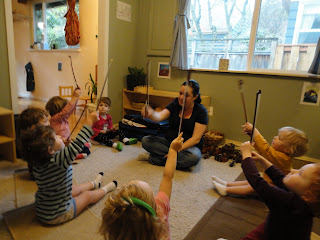This week was the first that many of our toddler and primary students attended Suzuki Violin lessons with Kari Wax. Kari is a trained Montessori guide (0-6yrs) and is currently teaching at the Montessori school of Alemeda. She and her husband (who is attending MINW this year) moved to Portland from Arizona with their three children earlier this fall.
Kari is also a trained Suzuki violin instructor and has been giving Suzuki violin lessons in Montessori schools for many years. She thoughtfully combines her understanding of the Montessori classroom with her Suzuki training to provide a wonderfully rich and fun musical experience for the children!
More than fifty years ago, Japanese violinist
Shinichi Suzuki realized the implications of the fact that children the world over learn to speak their native language with ease. He began to apply the basic principles of language acquisition to the learning of music, and called his method the
mother-tongue approach. The ideas of parent responsibility, loving encouragement, constant repetition, etc., are some of the special features of the Suzuki approach.
Since an integral part of the Suzuki method is parent involvement and the CMS students attend their lessons while still in school one way that we'd like to keep parnets engaged is by posting a weekly update on the CMS blog.
Here's is Kari's note about this weeks lesson:
Our first week of violin lessons was a great success! I was so pleased to find that the children were all very excited to begin. We "moved our feet to the beat" of the drum, and then we used careful listening skills as we jumped on the word "POP" in the song Pop Goes the Weasel. We sang Twinkle Twinkle Little Star legato style as we pretended to smoothly swirl water. Then we sang it again staccato style and pretended to splash the water. We learned the parts of the violin through a song, made a rest position cradle under our arms, and practiced our bows. Other highlights included tapping out rhythms both pianissimo and fortissimo (soft and loud) with rhythm sticks, air bowing with our violin bows, and practicing proper playing position. And the grand finale to our class was plucking "POP" on our violin strings as we sang Pop Goes the Weasel.










.JPG)


.JPG)
.jpg)
.JPG)